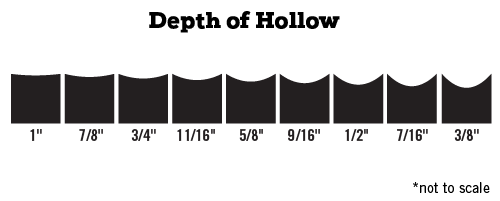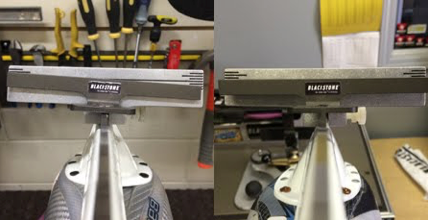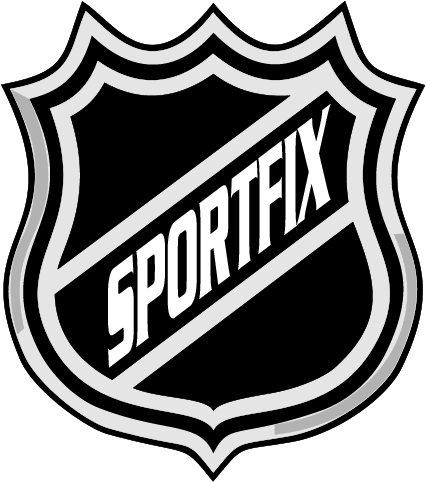CUSTOM SKATE SHARPENING
HOW IT'S DONE
Taking a look at the bottom of your skates, you will notice that the blade does not have one edge like a knife, but instead has two edges that are connected by a hollow in the blade.
This hollow shape is created by passing the blade along a grinding wheel. When sharpening skates, passing the skate blade along the wheel, parallel to the direction of the wheel’s motion, will shape out this hollow into the bottom of your blade.
Your skate is clamped into a jig (this will allow for the skate and blade to be held horizontally) which is aligned with the finishing wheel. The blade is then gently passed along the finishing wheel a number of times, until the edges are sharp and the bottom is fully hollowed out.
Sometimes, before using the finishing wheel, it’s necessary to use an additional wheel, called a cross-grinder, to prep the blade for finishing. Unlike the finishing wheel, the cross-grinder runs perpendicular to the skate blade and is designed to dull and flatten the blade.
The blade is flattened or “reset” to a flat bottom, ready to be re-finished. Cross-grinding isn’t required for most sharpenings, but is great at removing defects such as bad sharpenings, major pockmarks or burrs, and deep rust. It’s also used whenever a skate is being sharpened for the first time.
CUSTOMIZING YOUR SHARPENING
There are several areas to skate sharpening that can be customized, the most common is the hollow.
The hollow can be modified to have a very curved surface like a section of a small circle, or it can be flatter, like a section of a larger circle. Changing the shape of the finishing wheel’s surface will alter the size of the hollow it leaves on the blades of your skates.

SMALLER RADIUS HOLLOW
- ⅜”, ½” hollows
- Deeper cut on the blades
- Suited to lighter players who dig into the ice less
- Greater energy lost to the ice, creating extra effort required to skate
- Slightly lower top speed
- Agile and responsive turns and stops
- Quicker, more explosive acceleration
LARGER RADIUS HOLLOW
- ⅝”, ¾”, 1″ hollows
- Flatter cut on the blades
- Suited to heavier players who grip the ice easier
- Less energy lost into ice
- More efficient skating
- Faster top speed
- Less agile and stops will be less quick or sharp
- Acceleration is slightly limited
SKATE CONTOURING, PROFILING, OR ROCKER

CONTOURING
The terms “contour, profile, and rocker” essentially mean the same with respect to customizing skates.
Profiling the blades sets the flat length of the skate blade (from heel to toe) that will be contact with the ice . The most common sizes are a 9′, 11′, and 13′ radius, but we don’t limit to just these three.
A smaller profile will have less of the skate blade come in contact with the ice. While a larger profile will have more of the skate blade coming in contact with the ice.
Both have pros and cons that must be considered by the needs for each individual player/skater. Generally, a smaller radius is better for agility and maneuverability and a larger radius is better for speed and glide.
So these points are starting considerations to keep in mind when you’re deciding where to begin with your experiment.

PITCH
When dealing with the pitch (or lie) of the skate blade, we’re considering the posture of the skater.
Basically, we’ll adjust where the center of your profile will sit as it relates to the skate blade.
Moving the center backwards and the skater will be on their toes more. Moving it forwards and they’ll sit back on their heels more.
Traditionally, forwards would prefer to be up on their toes a bit more and defensemen a little more upright, but in reality this is a very personal customization.
Every skater has a posture that varies, so finding the right pitch for you will take some trial and error. If you want to experiment with the pitch of your blade, come and speak to us at the same time you are having your profile applied.
WHY BRING YOUR SKATES TO US?

When skates are sharpened incorrectly they can be unusable until the problem is fixed. The two common major issues that can do this are improper alignment and improper cross-grinding. In either case, the only solution is to get your skates re-sharpened, ideally somewhere that does a better job – like SportFix.
IMPROPER ALIGNMENT
This happens when the sharpener hasn’t properly aligned your skate blade with the grinding wheel and will cause one edge to be longer than than the other – resulting in the skates to have good bite when turning or stopping in one direction, but will feel like they’re slipping when turning or stopping in the other direction.
When looking down the length of the blade, you can see one edge is higher than the other. A coin, or flat gauge will appear to be tilted down in the direction of the lower edge.
At SportFix, our Professionals will ensure PROPER alignment of the edges before returning them back to you.
IMPROPER CROSS-GRINDING
As mentioned earlier, cross-grinding is the method to prep brand new skates for sharpening, or to remove rust or other imperfections (even uneven edges) left over from a previous sharpening.
While cross-grinding “resets” the blade, it does also removes much more of the overall steel from the blade than the finishing wheel. Hockey Shops will sometimes cross-grind every time they sharpen, causing your blades to have a lifespan of about ⅓ of what they would have without cross-grinding.
To ensure the longevity and precision of your blades life, SportFix will determine if a light cross-grind to take off only the edges, without removing the entire hollow, is required.
A WORD FROM US:
At SportFix, we’ll work with you to determine the best profile and hollow radius to meet your needs on the ice.
SKATE SERVICES
- Standard Sharpening
- Contouring
- Pro-V Sharpening
- Boot Repair
- Rivet Repair
SHARPENERS
Mike Gout, Kyle Best, Tim Simmon, Randy Isenberg
Date
18 November, 2020
CATEGORY
Hockey Equipment, Skates, Skate Sharpening
